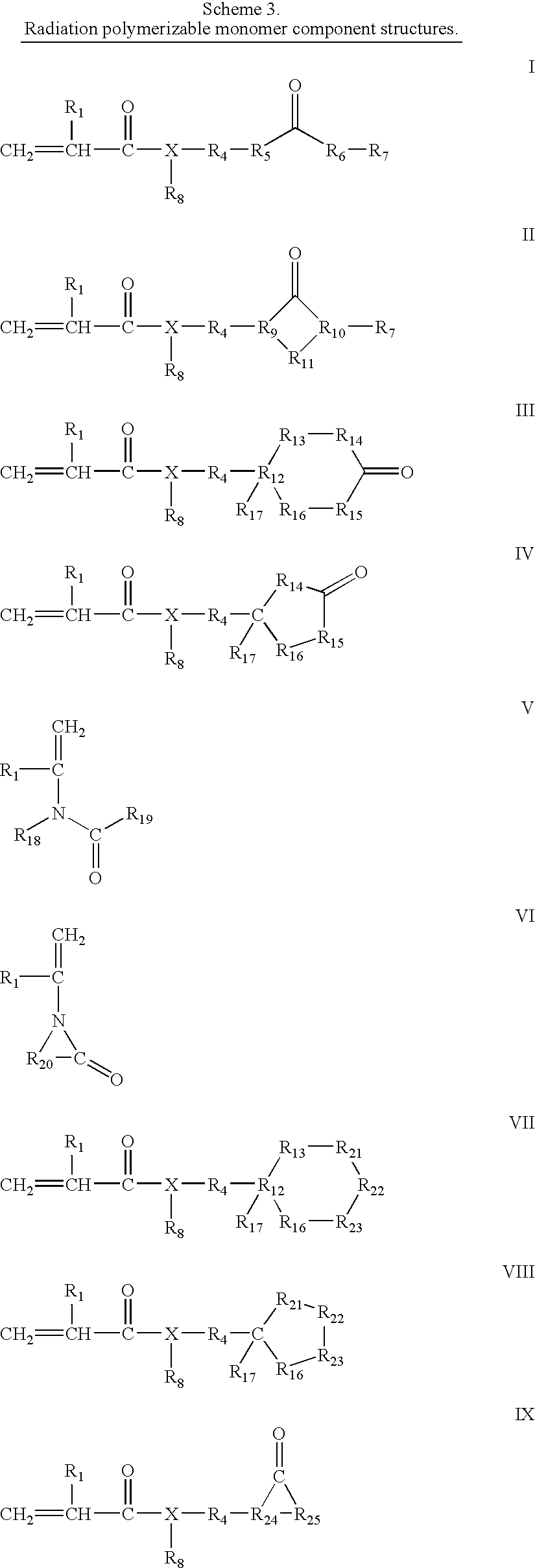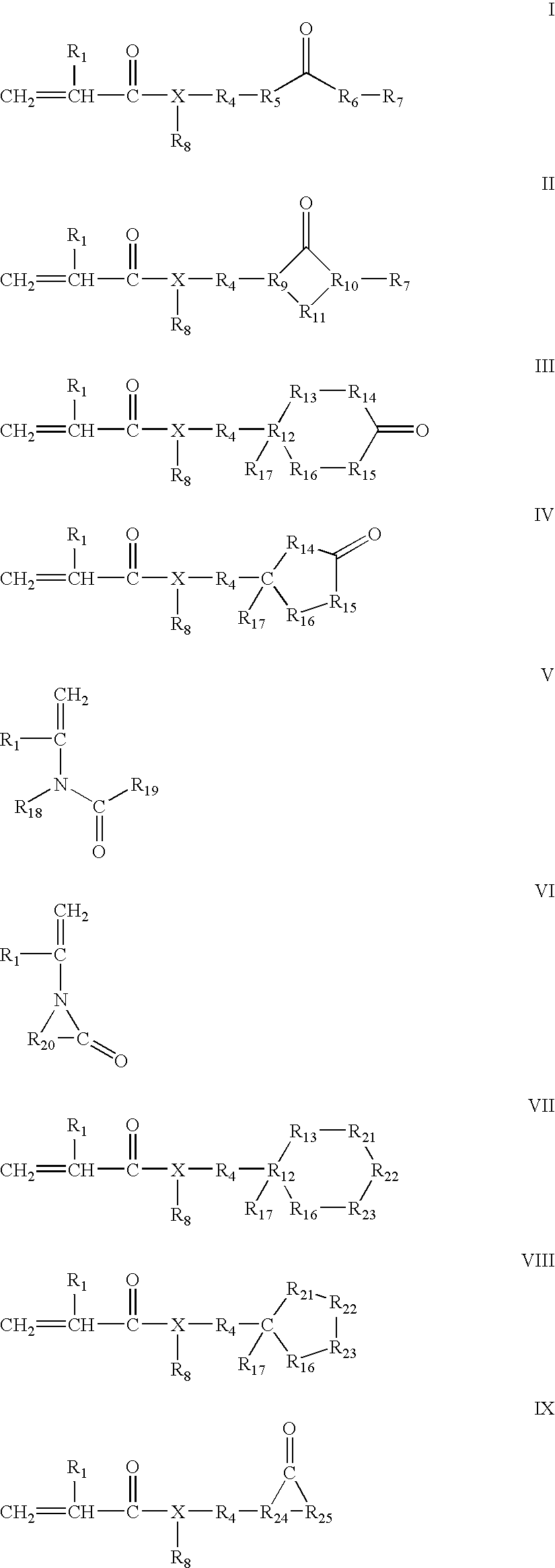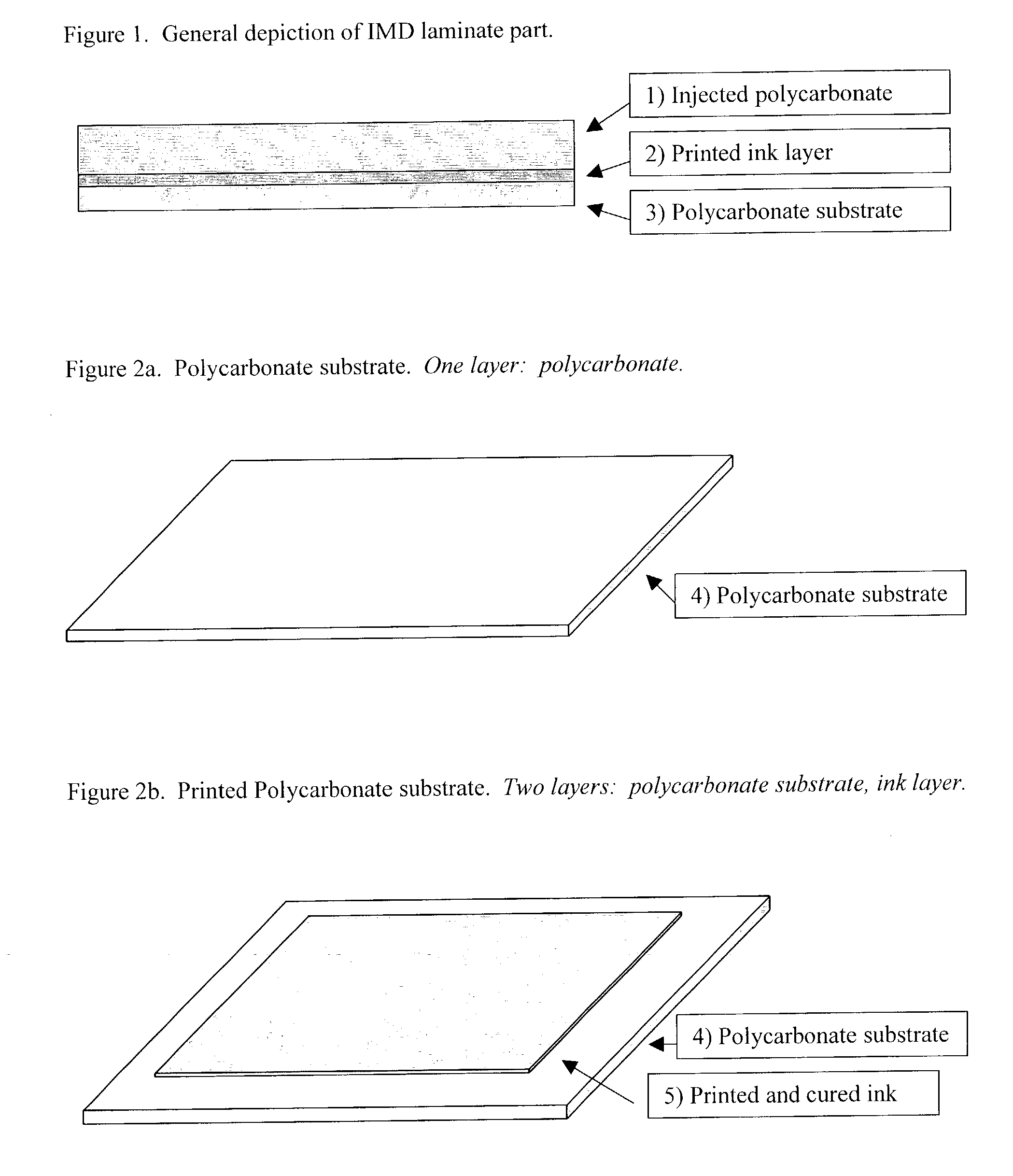Flexible radiation curable compositions
- Summary
- Abstract
- Description
- Claims
- Application Information
AI Technical Summary
Benefits of technology
Problems solved by technology
Method used
Image
Examples
example 1
[0217] A UV-polymerizable ink composition was prepared via the process outlined previously being composed of: 31.54 g RX04935 (polyester-based urethane acrylate), 15.14 g RX04945 (polyester / polyether urethane acrylate), 20.81 g IBOA (UCB Chemicals), 8.88 g RD RX / 201, 3.78 g NVP, 7.57 g Ebecryl.RTM. 7100 (UCB Chemicals), 0.50 g TEGO.RTM. Foamex N (Goldschmidt Chemical Corporation), 0.53 g Zonyl.RTM. FSG (Dupont), 1.89 g magenta pigment, and 9.34 g Viacure DX / LX photoinitiator blend (UCB Chemicals). The ink was printed on a Lexan.RTM. 8010 polycarbonate sheet by hand in two layers using Durometer A70 squeegee through a 355 / 34 pw mesh screen with 17-19N / cm tension, and cured in two passes through a Fusion UV Systems curing unit with two 600-H bulbs at about 80 ft / min. The ink showed excellent adhesion to the Lexan.RTM. substrate and was not tacky to touch. The ink was then tested for adhesion in IMD laminates. Results are given in Table 1.
[0218] Inks in five colors (cyan, magenta, yell...
example 2
[0219] A UV-polymerizable ink composition was prepared via the process outlined previously being composed of: 6.08 g RX04935 (polyester-based urethane acrylate), 43.24 g RX04944 (polyester / polyether based urethane acrylate), 18.72 g IBOA (UCB Chemicals), 16.22 g RD RX / 201, 5.41 g Ebecryl.RTM. 7100 (UCB Chemicals), 0.54 g TEGO.RTM. Foamex N (Goldschmidt Chemical Corporation), 3.04 g magenta pigment, and 6.76 g Viacure DX / LX (UCB Chemicals). The ink was printed on a Lexan.RTM. 8010 polycarbonate sheet by hand in two layers using Durometer A70 squeegee through a 355 / 34 pw mesh screen with 17-19N / cm tension, and cured in 2-3 passes through a Fusion UV Systems curing unit with two 600-H bulbs at about 80-120 ft / min. The ink showed excellent adhesion to the Lexan.RTM. substrate and was not tacky to touch. The ink was then tested for adhesion in IMD laminates. Results are given in Table 1.
example 3
[0220] A UV-polymerizable clear-coat composition was prepared via the process outlined previously being composed of: 24.18 g RX04918 (polyester / polycarbonate based urethane acrylate), 11.38 IRR 381 (polyester based urethane acrylate), 32.72 g RX03593, 22.76 g RD RX / 201, 4.27 g Ebecryl.RTM. 7100 (UCB Chemicals), 0.43 g TEGO.RTM. Foamex N (Goldschmidt Chemical Corporation), and 4.27 g Darocur.RTM. 1173 (Ciba.RTM. Specialty Chemicals). The clear coat was printed in two layers on-top of a standard magenta ink which was composed of: 63.91 g Ebecryl.RTM. 8411, 5.46 g IBOA (UCB Chemicals), 13 g NVP, 5 g Ebecryl.RTM. 7100 (UCB Chemicals), 0.18 g TEGO.RTM. Foamex N (Goldschmidt Chemical Corporation), 4.46 g magenta pigment, and 8 g Viacure DX / LX . The ink was printed on a Lexan.RTM. 8010 polycarbonate sheet by hand in two layers using Durometer A70 squeegee through a 355 / 34 pw mesh screen with 17-19N / cm tension, and cured in 2-3 passes through a Fusion UV Systems curing unit with two 600-H b...
PUM
| Property | Measurement | Unit |
|---|---|---|
| Fraction | aaaaa | aaaaa |
| Percent by mass | aaaaa | aaaaa |
| Percent by mass | aaaaa | aaaaa |
Abstract
Description
Claims
Application Information
 Login to View More
Login to View More - R&D
- Intellectual Property
- Life Sciences
- Materials
- Tech Scout
- Unparalleled Data Quality
- Higher Quality Content
- 60% Fewer Hallucinations
Browse by: Latest US Patents, China's latest patents, Technical Efficacy Thesaurus, Application Domain, Technology Topic, Popular Technical Reports.
© 2025 PatSnap. All rights reserved.Legal|Privacy policy|Modern Slavery Act Transparency Statement|Sitemap|About US| Contact US: help@patsnap.com



